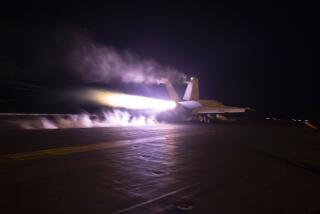SEAL Team 6 members among 38 killed in Afghanistan
- Share via
Reporting from Kabul, Afghanistan, and Washington — Their name conjures up the most celebrated moment of America’s post-Sept. 11 military campaigns. Now the Navy SEALs belong to a grimmer chapter in history: the most deadly incident for U.S. forces in the 10-year Afghanistan war.
Three months after they killed Al Qaeda leader Osama bin Laden in neighboring Pakistan and cemented their place in military legend, the SEALs suffered a devastating loss when nearly two dozen of the elite troops were among 30 Americans who died when their helicopter was shot down in Afghanistan early Saturday.
It was the largest number of American troops killed in a single day in the war. U.S. officials said the helicopter appeared to have been felled by enemy fire, and the Taliban quickly claimed responsibility. Seven Afghan commandos and a civilian interpreter also were killed, Afghan President Hamid Karzai said.
No member of the Bin Laden raid team was among the dead, said a Pentagon official briefed on the casualties who was not authorized to speak publicly while families still were being notified. But he said 22 of the 30 were Navy SEALs, and a significant number were members of SEAL Team 6, the unit that conducted the Bin Laden raid and is made up of just a few hundred of some of the best-trained fighters in the U.S. military.
The loss of so many represents a significant blow to a tightknit group that is involved in some of the most sensitive U.S. counter-terrorism operations around the world.
There was no indication that insurgents knew that many aboard the doomed Chinook were Team 6 members. But the Taliban and its allies are likely to reap an enormous propaganda boost from the deaths. The Taliban often seeks to appeal to the country’s folkloric sensibilities by depicting battlefield exploits in florid fashion; videos and songs trumpet various successes against foreign “invaders,” and any victory against NATO forces is held up as proof of divine inspiration and guidance.
The downing of the U.S. helicopter in mountainous Wardak province comes at a crucial juncture of the war, as the U.S. begins a drawdown in troops in a prelude to a full-fledged withdrawal.
The episode could embolden the insurgency at a time when Western and Afghan officials have been hoping a weakened Taliban movement can be lured to the bargaining table. Like the assassination last month of Karzai’s powerful half brother, it will be viewed by many as a sign of the insurgents’ reach and power.
A statement from Karzai’s office offered condolences to President Obama and the families of the Afghan troops who died.
In the early hours Saturday, the SEALs joined other U.S. Special Operations forces on a raid in Wardak province, west of Kabul, the capital. Such is the clockwork regularity of these nighttime raids that they have become almost routine.
But this one went horribly awry.
A Western military official, speaking on condition of anonymity, said the twin-rotor CH-47 helicopter had apparently been brought down by a rocket-propelled grenade moments after takeoff from the raid, when it was most vulnerable to attack.
White House national security advisor Tom Donilon notified Obama of the incident shortly after 8 p.m. Friday, said a White House official who was not authorized to speak publicly.
“Their deaths are a reminder of the extraordinary sacrifices made by the men and women of our military and their families,” Obama said in a statement Saturday. “We will draw inspiration from their lives, and continue the work of securing our country and standing up for the values that they embodied.”
Marine Gen. James N. Mattis, commander of U.S. Central Command, said: “We grieve for our lost comrades and especially for their families, yet we also remember that the lads were doing what they wanted to be doing and they knew what they were about. This loss will only make the rest of us more determined, something that may be difficult for those who aren’t in the military to understand.”
The SEALs and their special operations counterparts “conduct these missions night after night knowing that every mission could be their last,” said a Special Operations officer who asked not to be identified. “And despite this tragic loss for the units and our nation, tonight their brothers will board helicopters and go out and do the work our country has asked of them. And they will continue to do so without hesitation or mental reservation as they go after the enemies that would do us harm.”
Team 6, known officially as the Naval Special Warfare Development Group, is overseen by the Joint Special Operations Command, which also supervises the Army’s Delta Force and other elite units.
Those commandos, working closely with the CIA and other intelligence agencies, have embarked on a significant increase in nighttime raids over the last year in Afghanistan, targeting Taliban leaders, bomb-makers and other key adversaries. It is one of the little-known stories of the Afghan war, because the raids are secret and the results are rarely announced.
Those strikes have been the single most successful tactic employed by the Western military over the last two years, U.S. officials say, significantly damaging the field-command structure of the Taliban and affiliated insurgent groups.
SEAL Team 6 is divided into numerous detachments that rotate into Afghanistan. The SEALs who killed Bin Laden were handpicked and considered the top members of the unit.
They rehearsed the Bin Laden raid for weeks, but many military officials said that operation was not much different from the lesser-known raids that happen every day.
In Saturday’s attack, the helicopter went down shortly after midnight in the Sayedabad district, according to Shahidullah Shahid, a spokesman for the provincial governor. He and other provincial officials said the crash followed a firefight that had left eight insurgents dead.
Large and slow-moving, the Chinook is vulnerable as it flies through mountains and valleys that allow insurgents clear lines of fire. Even so, helicopter shoot-downs have been rare in the Afghan conflict.
But they have been deadly for U.S. troops. Before Saturday, the highest single-day loss for the U.S. military in Afghanistan came on June 28, 2005, when a Chinook carrying 16 Navy SEALs and Army special operations troops was shot down in Kunar province as it tried to rescue four SEALs in a firefight. All 16 were killed in the crash, and three SEALs died on the ground.
In a statement Saturday, the Taliban claimed its fighters had ambushed Western troops after being tipped off to an imminent night raid in the district. If true, that would amount to a devastating breach of U.S. operational security.
The Taliban statement, from spokesman Zabiullah Mujahid, was unusually specific in some of its details, including the number of troops killed — even before Afghan officials released the number. The statement also confirmed the “martyrdom” of eight of its members in what was described as fierce combat before the helicopter was shot down.
The crash site is in Wardak’s Tangi Valley, where the insurgents are active.
The Wardak police chief, Gen. Abdul Qayuum Baqizoi, said the American strike was aimed at a clandestine meeting of insurgent figures in the village Jaw-e-Mekh Zareen, which is considered a perilous locale. “This area isn’t even safe for security forces to travel in,” he said.
King reported from Kabul and Dilanian and Cloud from Washington. Times staff writer Tony Perry in Redding and special correspondents Aimal Yaqubi and Hashmat Baktash in Kabul contributed to this report.
More to Read
Sign up for Essential California
The most important California stories and recommendations in your inbox every morning.
You may occasionally receive promotional content from the Los Angeles Times.











